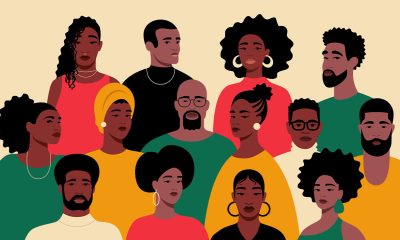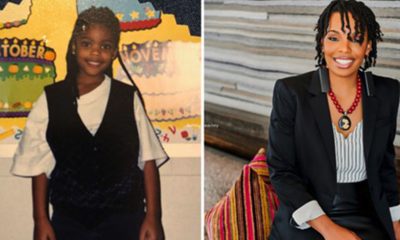California Black Media
Report: States Must Ban Guns at Places Where People Vote
Voting and elections have become the targets of threats and intimidation as the nation faces a proliferation of guns, more frequent gun violence, and fewer legal protections, noted Brennan Center for Justice and the Giffords Law Center to Prevent Gun Violence in a report released this week.
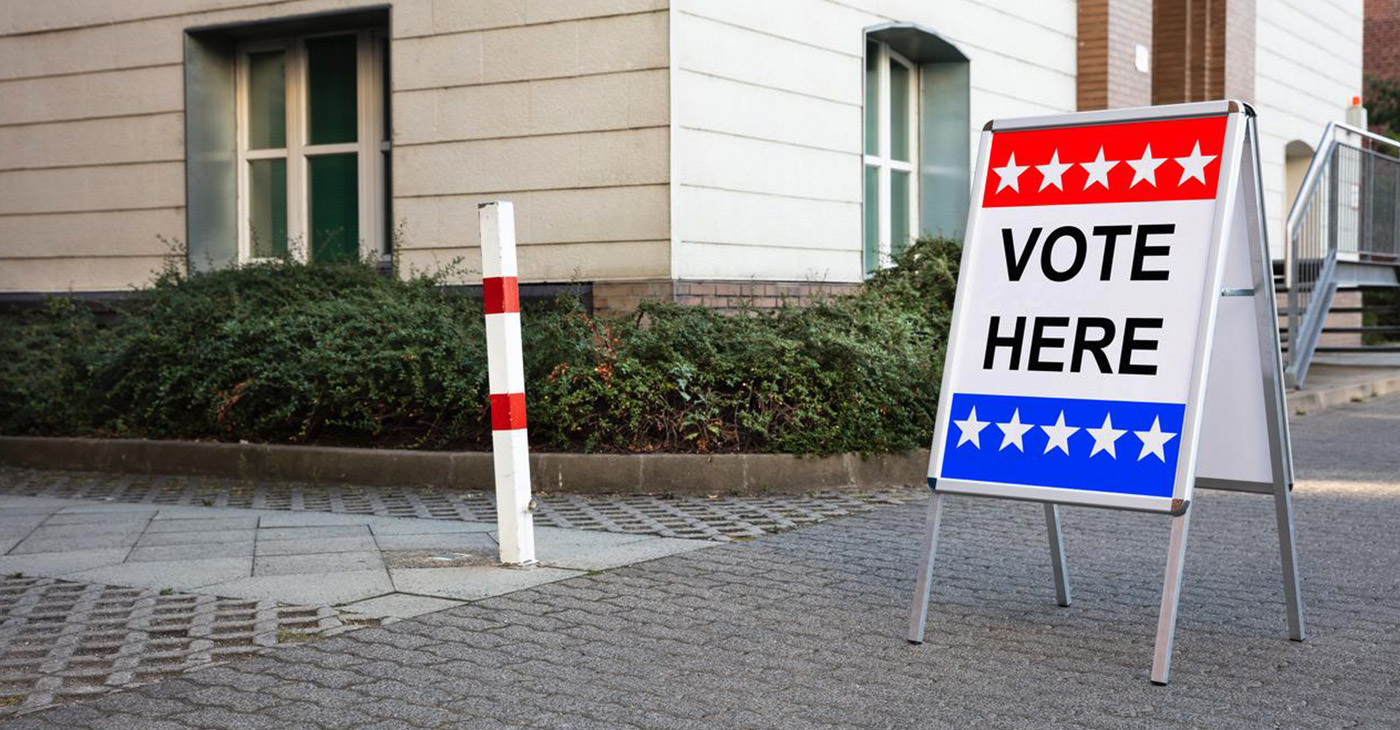
By Sunita Sohrabji, EMS
Special California Black Media
Voting and elections have become the targets of threats and intimidation as the nation faces a proliferation of guns, more frequent gun violence, and fewer legal protections, noted Brennan Center for Justice and the Giffords Law Center to Prevent Gun Violence in a report released this week.
The proliferation of guns in American homes has increased dramatically since 2008, when the Supreme Court ruled for the first time that the Second Amendment allows U.S. residents to possess an operable handgun in the home for self-defense.
“This was a considerable change from what the court had long held, which was that possessing a firearm had to be related to militia service,” Robyn Sanders, counsel for the Voting Rights and Election Reform Democracy Project at the Brennan Center, told Ethnic Media Services.
The Supreme Court did caution that the rights secured by the Second Amendment are not unlimited; it identified laws that would forbid firearms in sensitive places, such as schools and government buildings. “And so there, while the Supreme Court handed down what was a dramatic decision at that time, it did specify that regulations are still permissible in places that are sensitive,” said Sanders, who co-authored the report.
But the Supreme Court further weakened gun restrictions last year in its ruling on the New York State Rifle & Pistol Association, Inc. vs. Bruen case. The opinion, written by Justice Clarence Thomas, stated that the American public has the right to carry guns in public for self-defense, and that states cannot require applicants to demonstrate a need for owning a gun.
“The decision in Bruen has invited more legal challenges to gun regulations. But the court also explicitly states that sensitive places are places where states can regulate where guns can be carried, and they were unequivocal about polling locations being one of those,” said Sanders.
In a Sept. 20 interview with EMS, Sanders discussed the threat gun violence poses for U.S. elections. “We believe this report served a significant purpose in alerting states that there are ways that they could help to maintain the confidence that voters historically had in our elections as being safe and secure from violence and intimidation,” she said.
Excerpts of Conversation with Sanders:
What types of justifications are states using to allow concealed guns at polling sites and drop-off boxes?
The Supreme Court was unequivocal in its decision in Bruen that prohibiting firearms in polling places is constitutional. And so, while I can’t speak for why states have not filled the voids that we recognize in our report, what I can say is that we are offering policy proposals for states to enact laws that would better protect voters and election officials and workers from threats and help voters and the public remain confident that our elections will continue to be by and large peaceful.
Older adults traditionally account for the majority of election workers. Have you seen a drop-off of older adults choosing to work at the polls, given the uncertainty of protection from violence at those sites?
We were experiencing a global pandemic in 2020. And so there was a downturn in retired or elderly folks serving as election workers due to the vulnerabilities related with COVID -19.
Compared to anything prior, there was dramatically more harassment and threats lodged at election officials and poll workers over the last two election cycles. Poll workers have reported experiences of harassment and threats of abuse in recent years.
Are election workers of color more likely to face harassment, violence and intimidation?
We found that election officials serving what’s known as majority minority jurisdictions were more likely than election officials overall to report having been threatened, having been harassed or abused because of their job. And they were also considerably more likely to be concerned about being assaulted.
This is alarming, it’s concerning, and it’s unacceptable in a democracy.
One out of every 3 election workers have reported harassment or threats, according to the report.
As a result of the shifts in how our electoral process was being carried out, we started to observe trends in elected leaders and others who were spreading disinformation and misinformation about our elections as it relates to various methods of voting, including voting by mail and the use of drop boxes as a result of the uptick in mail voting.
And so based on that climate, we started to see an increase in threats and intimidation and threats of violence being lodged at election workers and officials.
Could you talk about some of your policy recommendations?
One of the key findings in our report is that only 12 states and Washington, D.C. have laws prohibiting open carry and concealed carry at polling places. And even fewer states have laws that prohibit guns where other sensitive election activity occurs drop boxes as well as places like election counting facilities.
And while it is illegal to intimidate voters in all 50 states, neither federal law nor any state law explicitly acknowledges that guns in or around places where people are engaged in voting or conducting election activity can constitute illegal intimidation.
In our report, we offer two main policy proposals. One: we recommend that states enact laws to prohibit guns at and around all sites of voting and vote counting. And we recommend that states strengthen their laws, protecting voters and election workers and officials from intimidation and violence, but explicitly addressing the void that is currently present and addressing the intimidating effect of guns.
I would reiterate to voters that — because our elections have remained by and large peaceful — the proposals that we offer in our report are simply action items that states can take to further strengthen legal protections that are already in place.
Activism
Oakland Post: Week of April 2 – 8, 2025
The printed Weekly Edition of the Oakland Post: Week of April 2 – 8, 2025
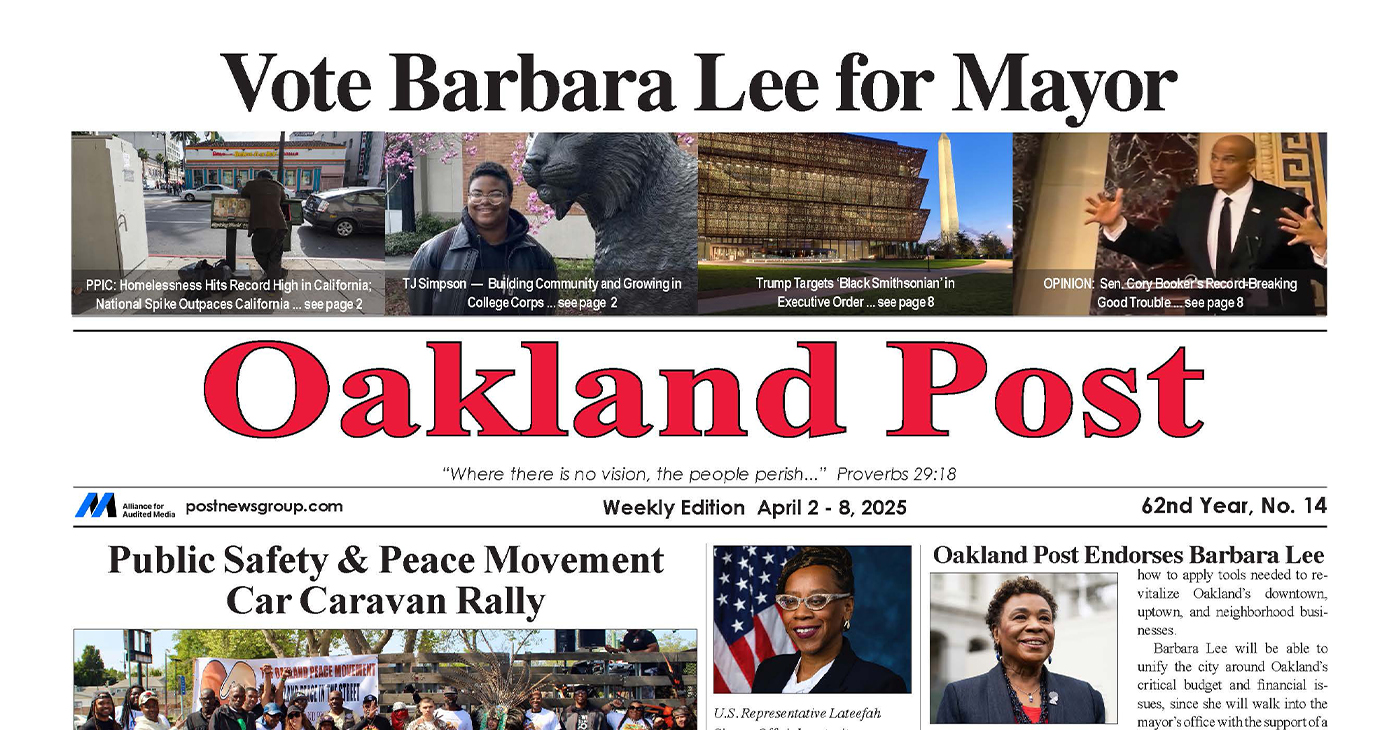
To enlarge your view of this issue, use the slider, magnifying glass icon or full page icon in the lower right corner of the browser window.
Activism
Oakland Post: Week of March 28 – April 1, 2025
The printed Weekly Edition of the Oakland Post: Week of March 28 – April 1, 2025
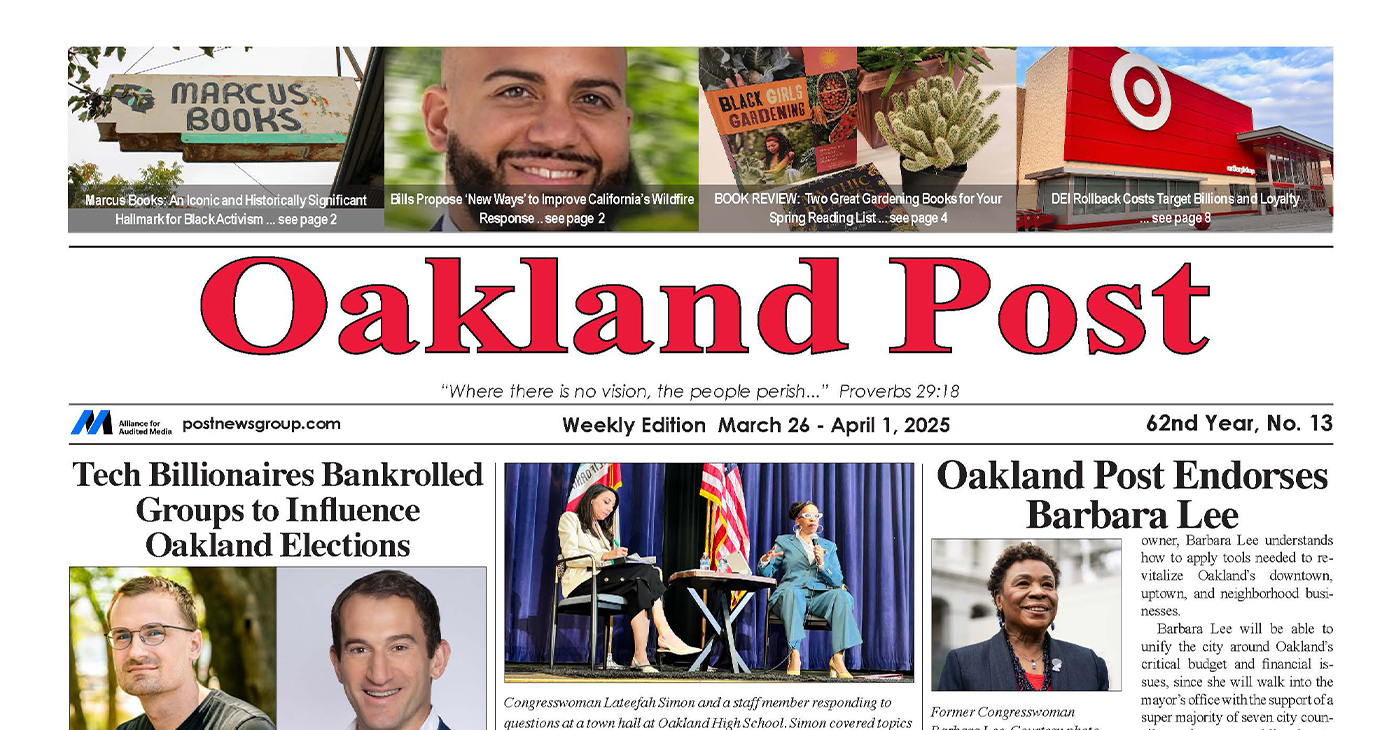
To enlarge your view of this issue, use the slider, magnifying glass icon or full page icon in the lower right corner of the browser window.
Activism
Sen. Lola Smallwood-Cuevas Honors California Women in Construction with State Proclamation, Policy Ideas
“Women play an important role in building our communities, yet they remain vastly underrepresented in the construction industry,” Smallwood-Cuevas stated. “This resolution not only recognizes their incredible contributions but also the need to break barriers — like gender discrimination.
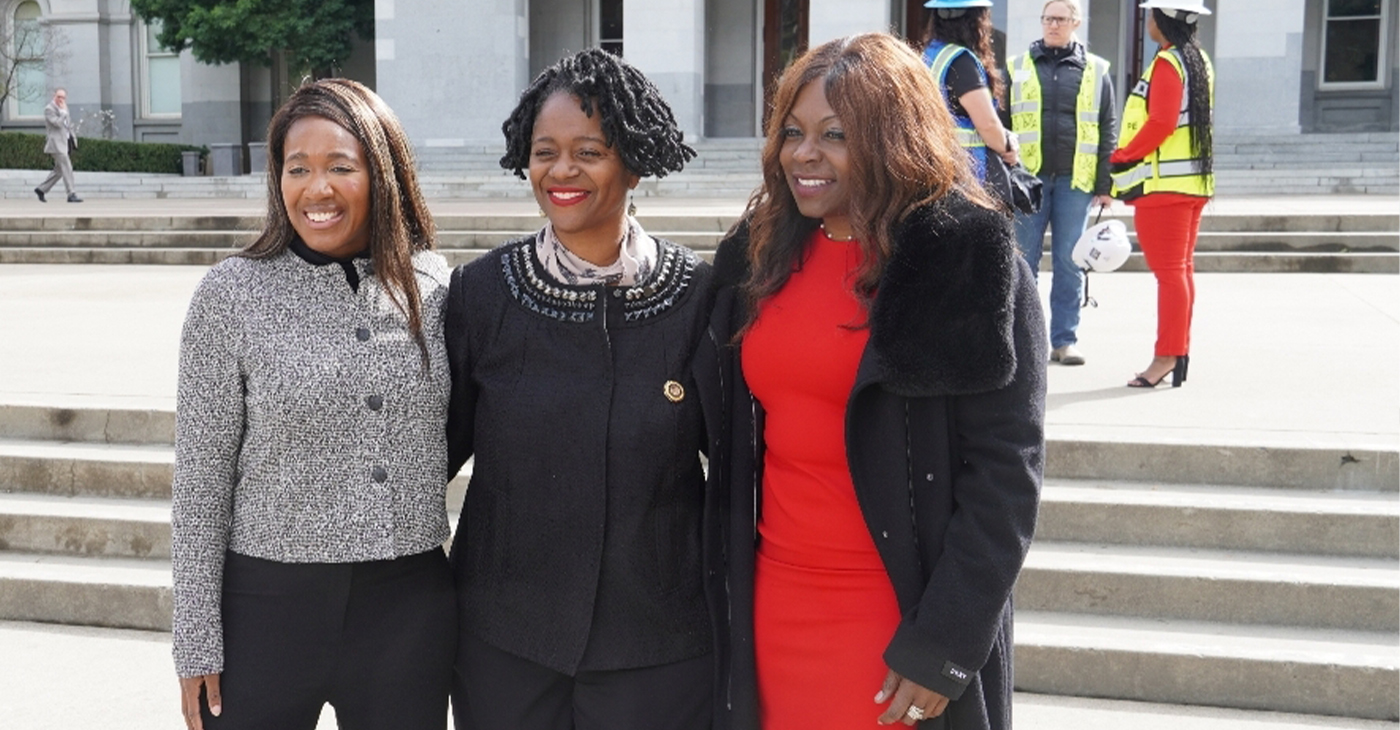
By Antonio Ray Harvey, California Black Media
To honor Women in Construction Week, Sen. Lola Smallwood-Cuevas (D-Los Angeles), a member of the California Legislative Black Caucus (CLBC), introduced Senate Concurrent Resolution (SCR) 30 in the State Legislature on March 6. This resolution pays tribute to women and highlights their contributions to the building industry.
The measure designates March 2, 2025, to March 8, 2025, as Women in Construction Week in California. It passed 34-0 on the Senate floor.
“Women play an important role in building our communities, yet they remain vastly underrepresented in the construction industry,” Smallwood-Cuevas stated. “This resolution not only recognizes their incredible contributions but also the need to break barriers — like gender discrimination.
Authored by Assemblymember Liz Ortega (D-San Leandro), another bill, Assembly Concurrent Resolution (ACR) 28, also recognized women in the construction industry.
The resolution advanced out of the Assembly Committee on Rules with a 10-0 vote.
The weeklong event coincides with the National Association of Women In Construction (NAWIC) celebration that started in 1998 and has grown and expanded every year since.
The same week in front of the State Capitol, Smallwood, Lt. Gov. Eleni Kounalakis, Assemblymember Josh Hoover (R-Folsom), and Assemblymember Maggie Krell (D-Sacramento), attended a brunch organized by a local chapter of NAWIC.
Two of the guest speakers were Dr. Giovanna Brasfield, CEO of Los Angeles-based Brasfield and Associates, and Jennifer Todd, President and Founder of LMS General Contractors.
Todd is the youngest Black woman to receive a California’s Contractors State License Board (A) General Engineering license. An advocate for women of different backgrounds, Todd she said she has been a woman in construction for the last 16 years despite going through some trying times.
A graduate of Arizona State University’s’ Sandra Day O’Connor College of Law, in 2009 Todd created an apprenticeship training program, A Greener Tomorrow, designed toward the advancement of unemployed and underemployed people of color.
“I always say, ‘I love an industry that doesn’t love me back,’” Todd said. “Being young, female and minority, I am often in spaces where people don’t look like me, they don’t reflect my values, they don’t reflect my experiences, and I so persevere in spite of it all.”
According to the U.S. Bureau of Labor Statistics, only 11.2% of the construction workforce across the country are female. Overall, 87.3% of the female construction workers are White, 35.1% are Latinas, 2.1% are Asians, and 6.5% are Black women, the report reveals.
The National Association of Home Builders reported that as of 2022, the states with the largest number of women working in construction were Texas (137,000), California (135,000) and Florida (119,000). The three states alone represent 30% of all women employed in the industry.
Sen. Susan Rubio (D-Baldwin Park) and the California Legislative Women’s Caucus supported Smallwood-Cuevas’ SCR 30 and requested that more energy be poured into bringing awareness to the severe gender gap in the construction field.
“The construction trade are a proven path to a solid career. and we have an ongoing shortage, and this is a time for us to do better breaking down the barriers to help the people get into this sector,” Rubio said.
-

 Activism2 weeks ago
Activism2 weeks agoWe Fought on Opposite Sides of the Sheng Thao Recall. Here’s Why We’re Uniting Behind Barbara Lee for Oakland Mayor
-

 #NNPA BlackPress3 weeks ago
#NNPA BlackPress3 weeks agoRev. Dr. Jamal Bryant’s Black Church Target Boycott Mobilizes 150,000
-

 Activism3 weeks ago
Activism3 weeks agoSan Francisco Is Investing Millions to Address Food Insecurity. Is Oakland Doing the Same?
-

 #NNPA BlackPress3 weeks ago
#NNPA BlackPress3 weeks agoRecently Approved Budget Plan Favors Wealthy, Slashes Aid to Low-Income Americans
-
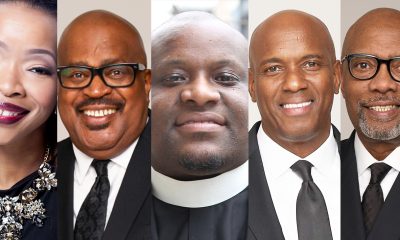
 Activism2 weeks ago
Activism2 weeks agoFaith Leaders Back Barbara Lee for Mayor, Criticize Candidate Loren Taylor for Dishonest Campaigning
-

 Activism3 weeks ago
Activism3 weeks agoOakland Post: Week of March 12 – 18, 2025
-

 Activism2 weeks ago
Activism2 weeks agoGroup Takes First Steps to Recall District Attorney Diana Becton
-

 #NNPA BlackPress3 weeks ago
#NNPA BlackPress3 weeks agoPRESS ROOM: The Urban One Podcast Network Announces Los Angeles Wildfires Podcast, ‘Altadena: After the Fire’





